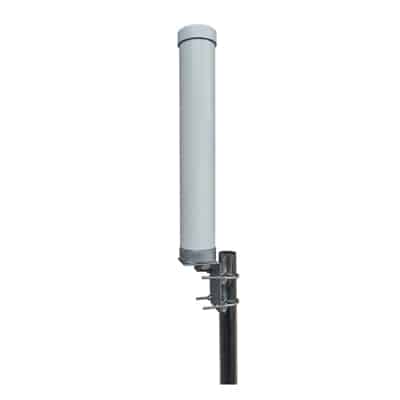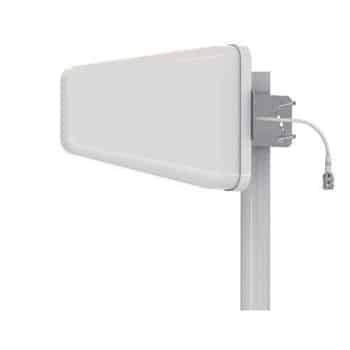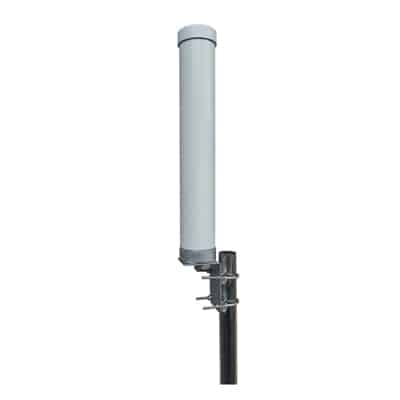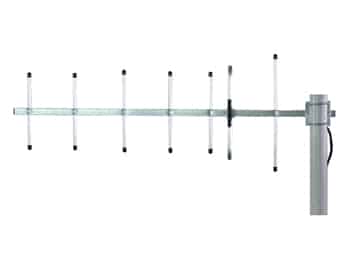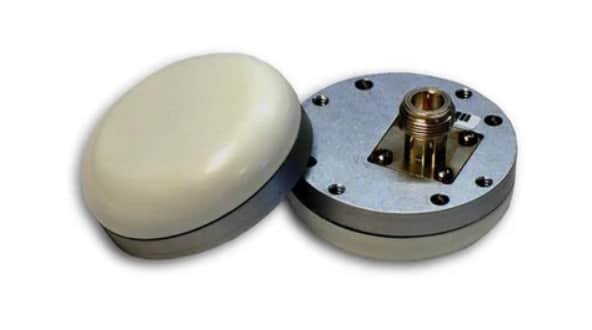
Antenna technology has advanced significantly with active antennas, which integrate active electronic components including amplifiers, filters, and signal processing units to provide improved performance. Active antennas are more successful in situations when signal strength is an issue because they employ their integrated electronics to enhance signals, as opposed to passive antennas, which only use their physical design to capture signals.
Active antennas support effective signal reception across a broader frequency range due to integrated amplifiers; however, the extra boost may cause the signal level to be sent at a higher output power than that allowed. This is why active antennas are usually used to receive signals, not transmitting them. Moreover, since some directional antennas add a built-in gain already, the extra gain on an active antenna may be unnecessary, and even harmful to some systems. This article explores the types, functions, benefits, uses, and difficulties of active antennas. It also compares them to passive antennas and includes pertinent case studies.
Table of Contents
ToggleWhat is an Active Antenna and How Does it Work?
An active antenna is a device that amplifies or modifies signals by fusing conventional antenna architecture with active electronic components. The antenna can do more than only receive and transmit signals thanks to the incorporation of active components like signal processors or low-noise amplifiers (LNAs).
An amplifier is a component of an active antenna. Longer cable runs are possible without sacrificing signal quality thanks to this amplifier, which strengthens the RF signals that the antenna receives. Additionally, The amplifier improves the signal-to-noise ratio by amplifying desired signals more effectively, often paired with filtering to minimize interference. Because of this, active antennas are perfect for usage in places like cities or factories where there is a lot of electromagnetic interference.
Active antennas can also be used to overcome signal loss from splitters or other distribution equipment or to compensate for signal loss in long cable runs. Because of this, they are helpful in applications like wireless microphone systems and cable television distribution. All things considered, active antennas offer a means of enhancing signal quality and reception in a variety of applications, making them an invaluable instrument for various sectors.
Working Principle
Usually, an amplifier circuit is linked to a tiny antenna element, like a loop or a dipole, to create an active antenna. The antenna element receives weak incoming signals, which are amplified by the amplifier circuit. The receiver or the rest of the radio system receives this boosted signal after that.
A battery or a power supply attached to the antenna can power the amplifier in an active antenna. The energy required for the amplifier to function and amplify the signals is supplied by this power source.
The core functionality of an active antenna involves:
- Signal Reception: The antenna receives electromagnetic waves.
- Amplification: The embedded active components boost weak signals to enhance clarity and strength.
- Signal Processing: Advanced active antennas can process the signal to filter out noise or undesired frequencies.
- Signal Transmission: In transmission mode, active components ensure efficient propagation by amplifying the signal power.
By integrating these active components, active antennas can operate more effectively in challenging environments, such as those with high interference or weak signals.
Types of Active Antennas
Active antennas can be classified based on design and application. Below are the primary types and their definitions.
- Active Receiving Antennas: These types are designed to amplify incoming signals, and are commonly used in communication systems where signal strength is a critical factor.
- Active Transmitting Antennas: These include built-in amplifiers to boost the power of the transmitted signals, ensuring wider reach and reliability. But, Active antennas are primarily used for receiving signals.
- Smart Antennas: Equipped with signal processing algorithms, these antennas can steer beams dynamically to focus on desired directions.
- Phased Array Antennas: Comprising multiple elements with phase-controlled signals, these antennas allow beam shaping and steering without mechanical movement.
- Wideband Active Antennas: These antennas operate over a broad frequency range, making them suitable for multi-frequency communication systems.
Advantages of Active Antennas
Active antennas offer several benefits compared to traditional passive antennas. When the antenna must be used with many devices or in locations with poor reception, active antennas offer a dependable and practical way to receive high-quality signals.
Some of the key advantages of active antennas include the following.
- Improved signal quality – Usually, active antennas come with built-in amplifiers that strengthen the signal, improving reception and signal quality. This is especially helpful in places where signals are weak or far away. The integration of LNAs ensures amplified signal reception, making them effective in weak signal environments.
- Extended range – Compared to passive antennas, active antennas can receive signals from a larger distance because of the amplification they give. Active components boost the transmitted signal’s power, extending the coverage area. In rural or isolated locations where the broadcast towers are far away, this can be extremely helpful.
- Multi-directional reception – Depending on their design, active antennas can be omnidirectional, allowing them to receive signals from multiple directions. Finding the optimal signal no longer requires constant antenna modifications due to the availability of omnidirectional or multidirectional reception.
- Energy Efficiency – Despite their enhanced capabilities, modern active antennas are designed to consume minimal power, making them suitable for portable applications.
- Compact size – Compared to conventional antennas, active antennas are typically more compact and smaller. Because of this, putting them on walls, windows, or even indoors is now possible, and installation is made simpler. By integrating active elements directly into the antenna, the overall system size can be reduced.
- Dynamic Functionality – Smart and phased array antennas provide capabilities such as beamforming, improving communication efficiency.
- Lower interference – Because active antennas have built-in amplifiers and signal processing capabilities, they are less vulnerable to interference from adjacent electrical equipment or structures. They can produce a more precise signal by removing unnecessary noise.
- Compatibility with various devices – Numerous active antennas are made to function with a range of devices, such as streaming devices, TVs, and radios. They are a practical option for various environments and applications because of their adaptability.
- Easy installation – Installing and configuring active antennas is usually simple. To help determine the best location, they frequently include mounting hardware, detailed instructions, and occasionally even integrated signal strength indicators.
- Future use – New broadcast standards and frequencies are increasingly likely to be supported by active antennas as technology develops. This implies that purchasing an active antenna now will guarantee compatibility with any upcoming broadcasting technology advancements or modifications.
Applications of Active Antennas
Active antennas are essential for enhancing signal reliability, quality, and range in a variety of wireless communication applications. Below are the applications where active antennas are used for a variety of purposes.
- Enhancing TV reception: Employed in radio and television broadcasting to enhance signal quality and coverage. In places where there is interference or poor signal strength, active antennas can be used to enhance TV reception quality.
- Wireless communication: Wi-Fi routers and other wireless communication devices employ active antennas to send and receive signals.
- Telecommunications infrastructure: Base stations and other telecom equipment use active antennas to send and receive signals for mobile communication.
- Cellular networks: Cellular networks utilize active antennas to increase coverage and signal strength. Also used in 5G infrastructure for improved connectivity.
- GPS navigation: In order to receive signals from satellites and deliver precise positional data, GPS systems need active antennas.
- Radar systems: Radar systems use active antennas to send and receive radio waves in order to track and detect things.
- Satellite communication: Satellite communication systems use active antennas to send and receive messages to and from satellites. Also utilized in aircraft for navigation and communication.
- Military applications: For reliable and safe connection, military communication systems use active antennas. Applied in radar systems, surveillance, and secure communication networks.
- Internet of Things (IoT): IoT devices use active antennas to facilitate wireless communication and connectivity.
Comparison with Passive Antennas
The most basic kind of antenna system is a passive one. With these, wireless signals travel through the system without any extra interference after passing from the network to the controller. The strength of the incoming signal is all that passive antennas can use; they are not capable of signal amplification. They are better suited for situations where cost is a key consideration since they are easier and less expensive to make.
In contrast, the signal is enhanced in some manner before distribution in an active antenna system. Usually, an amplifier that is linked to the controller will be used for this, but alternative signal-boosting techniques may also be used. Fiber optic connections, for example, are occasionally utilized to increase functionality. Active antennas are usually utilized in places with a high user density and dense urban areas where obstructions like trees and buildings weaken the signal. To make up for the signal loss brought on by these obstructions, they can boost it, guaranteeing a solid and dependable connection.
Passive antennas are frequently employed in less populated regions with high signal strength and few obstructions. They are adequate to deliver dependable connectivity without requiring signal amplification.
In conclusion, passive antennas are better suited for less urban locations with robust signal strength, whereas active antennas, particularly phased array systems, play a crucial role in addressing the challenges of 5G’s high-frequency spectrum in urban areas.
Challenges and Limitations
Despite their advantages, active antennas face certain challenges:
In huge buildings, many kinds of antenna systems are beneficial. After all, wireless communications are more likely to be interfered with in these kinds of buildings. The size of a building, however, can eventually work against an antenna system. Attenuation is the process by which the signal weakens when cables carry data over ever-greater distances. Reversing this process requires active antennas. They strengthen the signal and enable longer-distance transmission. Therefore, active antennas are very helpful in big buildings. In these situations, they can immediately address the inherent issues brought on by the building’s scale.
- Power Dependence: Active antennas require a power source, which can be a limitation in remote or power-constrained environments.
- Complexity: The integration of active components increases design and manufacturing complexity.
- Cost: Higher production costs can make active antennas less accessible for budget-constrained projects.
- Reliability Issues: Active components are more prone to failure compared to passive elements, necessitating rigorous quality control.
- Interference Management: Managing interference in densely packed active antenna systems can be challenging.
Case Studies
- 5G Network Deployment
When it comes to the deployment of 5G networks, active antennas have been essential. For example, in urban settings, phased array antennas with beamforming capabilities have made it possible to transmit data at high speeds and with lower latency.
- Military Radar Systems
Strategic benefits in defense applications are ensured by the higher performance of advanced radar systems using active antennas in identifying low-observable targets.
- Satellite Communication
Satellites with active antennae offer dependable communication connections even in unfavorable atmospheric conditions, underscoring their significance for connectivity and space research.
- GPS antenna
Active antennas are used in GPS antennas found in smartphones and satellite communication systems, where it is essential to sustain signal strength over extended distances.
- Wireless router
The Wi-Fi antenna found in wireless routers is another example of an active antenna. The wireless network’s range is increased, and the Wi-Fi signal is amplified with the aid of the active antenna.
Conclusion
By combining filtering and amplification into a small package, active antennas have completely changed signal processing and communication. They are essential in modern uses ranging from military to telecommunications due to their capacity to increase signal strength, lower noise, and dynamically adjust to changing circumstances. The importance of active antennas in future communication systems will be increased as a result of continued technological improvements that promise to address ongoing limitations like cost and power dependence.
When choosing between active and passive antennas, you should take into account a number of criteria, including price, application, and the number of devices that are supported. Some passive antennas may be less expensive than their active counterparts due to the absence of an amplifier, although active antennas are usually more compact and can reduce noise and interference. This article provides a comprehensive review of active antennas.

